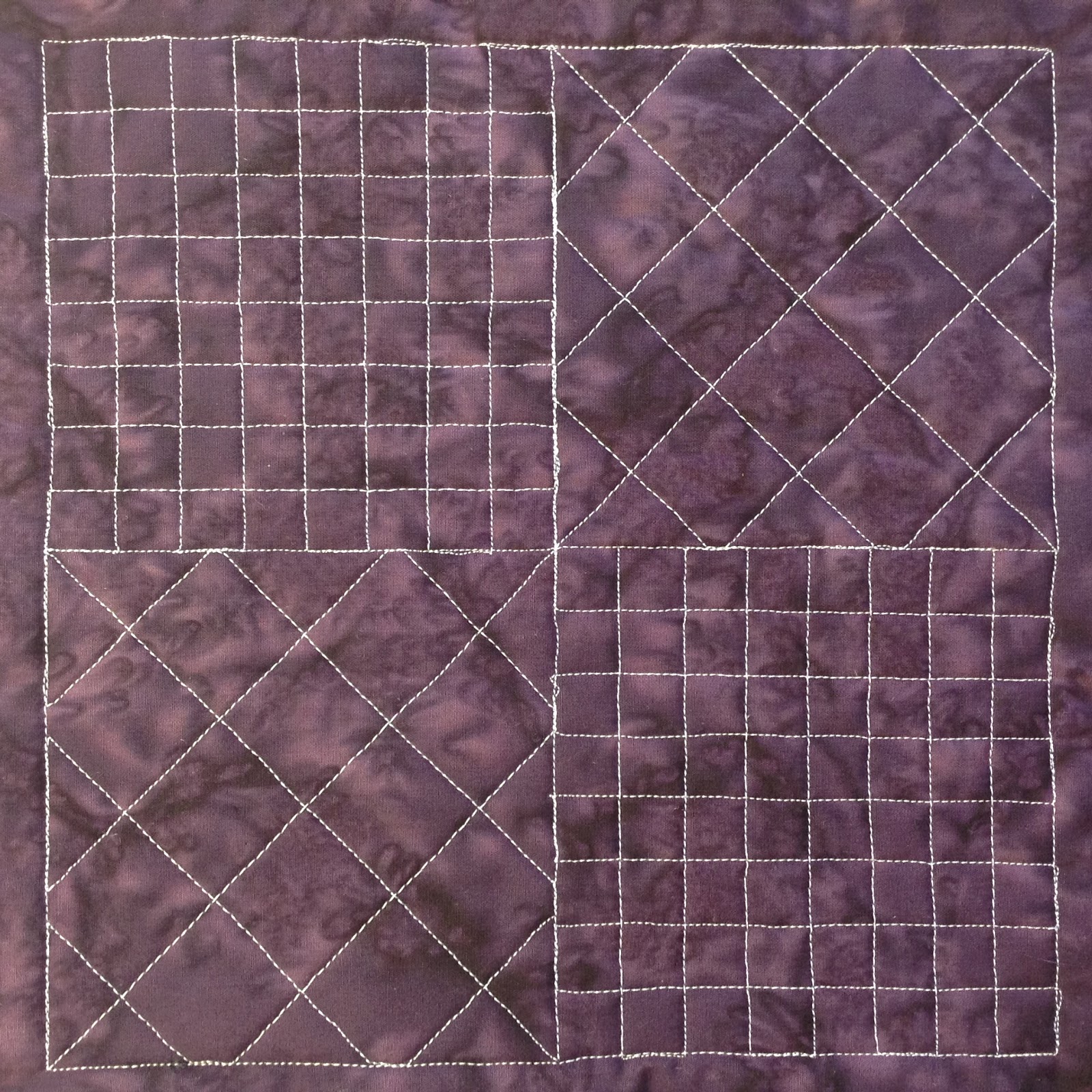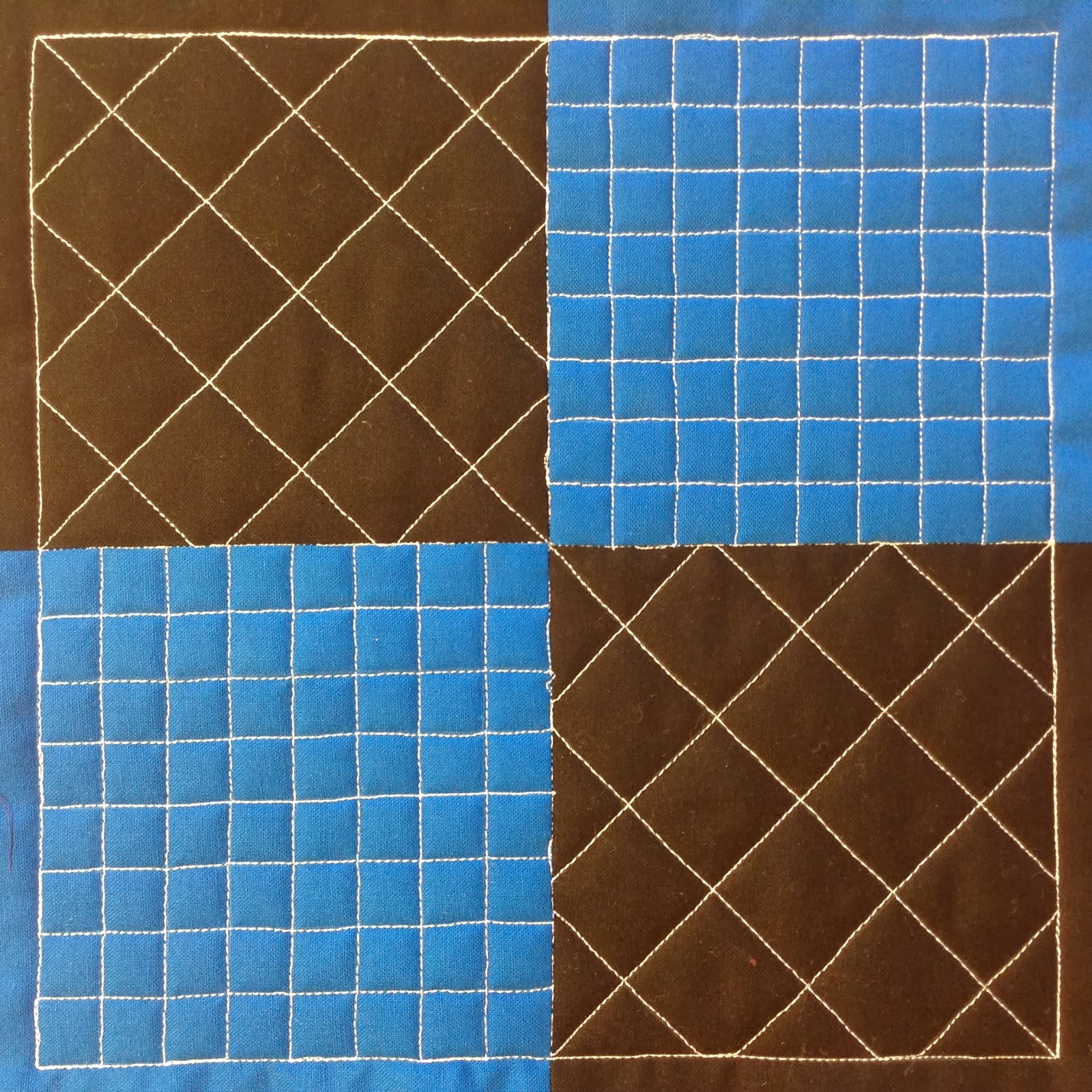3. Quilt a 4 Patch Block with Gridlines
Today we’re tackling another skill building design – straight lines that create gridlines:
Yes, I know what you’re thinking – But Leah, I could quilt this with my walking foot!
True, a walking foot can quilt straight lines like these perfectly, but that’s about ALL it can do. If there was any extra filling or fun designs in this block, you’d have to break thread, change feet, and start the cool stuff in free motion.
Learning to quilt both straight lines ans curvy designs in free motion means you will be able to quilt ANYTHING you want with one foot, one set of settings, and maybe even only one thread break. It’s faster, simpler, and once you master it, lots of fun too!
Let’s watch the lesson and see how this works:
Just in case you’re wanting to join in, you can pick up a copy of the Building Blocks Quilt Pattern right here to get started.
 Here’s a couple points from this video:
Here’s a couple points from this video:
Plan Your Path – It is never a waste of time to stop, think, and trace! You have full sized quilting guides so you can mark your blocks and practice tracing and moving through the space in the most logical way.
I got a lot of questions this week on the Facebook group about travel stitching and many members were worried about traveling through an area too much.
I don’t personally think there’s a problem with traveling over an area 3-5 times, but if your machine or your thread disagrees, they will let you know by breaking thread. It’s not a big deal, but it does save some time to think about your path from the beginning so you have the least amount of travel stitching to fill in the block.
Saving a 1 stitch mistake – If you stitch off your line, or out of the ditch, with just one stitch and the needle is down in the quilt, you can usually still recover this stitch by rotating the hand wheel backwards to lift the needle and reposition it.
Why backwards? Your top thread makes a circuit through the bobbin case. If you rotate the hand wheel towards you, or hit your needle up button, the circuit will be complete, the stitch will be made and the only way to fix it is to stop, break thread, pick it out, hide the tails, start again, hide those tails…you get the idea.
If you rotate backwards, you’re basically just pulling the top thread back out of the bobbin case and you can usually recover from this smoothly, so long as the stitch didn’t complete itself.
Don’t Rip – Even if you do stitch off a line, out of the ditch, or off the line you’re traveling, please don’t pick up your seam ripper to rip it out. We’re learning how to QUILT here, not rip, and perfection isn’t the goal of this project.
So that’s it for Gridlines! Swing back by tomorrow to see Josh’s video on this design and get more insight from his beginner’s perspective.
Let’s go quilt,
Leah Day


I finally got it all together today and could actually quilt. I got so excited I completed the first 3 blocks. 🙂 They are far from perfect but I promised myself I wouldn't obsess.
In the middle of the 3rd block, I looked at the clock and realized I missed going to my monthly knitting group at church! Sigh.
Oh well all 3 blocks are done and I'm psyched for the next set. I have wanted to learn this for so long. I can't believe I just happened to stumble on this site.
I don't have my own blog and don't use Facebook or Pinterest so cannot post any pictures.
Ok. I've sewn my "easy glidder" sheet to the back of a sample quilting piece. I've sewn my glove to another sample…What is next?
What I've learned in Block #2
I can quilt a line without using my walking foot.
I need a GPS to find the best way around the block.
I takes time to do this- no rushing.
I love my machine. I really really love my husband. He is so encouraging, even when he is hungry.
This is fun!
LOL Anne! How in the world are you sewing so many things to each other?! Thanks for the laugh. The visual image of all your tools all stitched to one another is certainly funny!
I am having so much fun!! I need help when you have to cut or break thread in the middle of a line of stitching. I got my needle stuck and had to cut thread. Now I have a thread on the bottom and three on the top and I have an empty spot where I stopped and then restarted. How do you handle this and keep a nice line of stitching?
Hi CcQuilts – This is a very normal issue to have! It takes time to get the hang of starting and stopping your stitching seamlessly. Don't obsess about this little mistake.
As for the threads. Give the single thread on the back of your block a tug and you should be able to pull the top thread down so you have 2 threads together. Tie them together and hide them in the middle layer of the quilt, then repeat with the 2 threads on the top.
This way both lines of stitching will be secured, and you might be able to hide the little gap between them!
Cheers,
Leah Day
I enjoyed quilting this block, but ended up with some bird nests on the back and a few loose stitches on the front. What do you suggest I do with these? I thought about cutting the bird nests and then restitching that part. What do you think?
Hi Ilene – If it's a really big bird's nest and the thread feels loose, like it could easily get caught on something, then yes, I would rip it out and quilt back over it to secure the stitching.
I broke a needle during travel stitching – how can I keep that from happening.